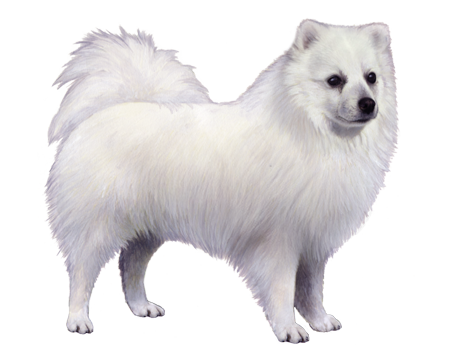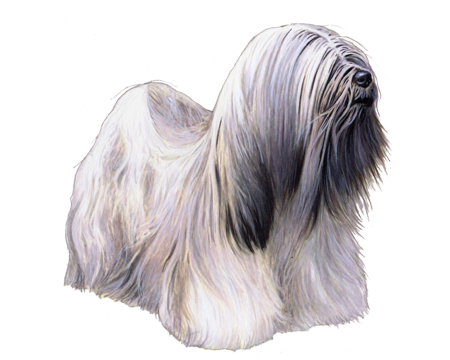
Havanese
The Havanese is the National Dog of Cuba. These smart, social, little dogs have relaxed attitudes, adaptable natures, and a downright adorableness that has made them one of the fastest-growing breeds in the nation.
Interested in discovering if your dog is a Havanese?
Check out Wisdom Panel's DNA tests.

Havanese Traits
General Appearance
Havanese are small, sturdy dogs with mischievous expressions and a spring in their steps.
Coat and Colouring
It takes one touch of their coats to understand why the Havanese had nicknames like Havana Silk Dog. Their coats are light in texture and silky to the touch. Long, abundant, wavy hair stands slightly off their bodies and flows with movement. Puppies have shorter coats with softer textures than adult Havanese.
Their coats can be black, black and silver, black brindle, chocolate, cream, fawn, red, silver, white, gold sable, and gold brindle.
Distinctive Physical Traits
The Havanese is slightly longer than tall, with shorter front legs and a rectangular shape. Their large, dark brown, almond-shaped eyes lend them an intelligent, mischievous expression. They have dropped ears with distinct folds and full, rectangular muzzles with broad noses.
Havanese Temperament
Although Havanese might not be the first breed that comes to mind for a guard dog, these are alert and intelligent dogs. They notice and alert their owners when something is amiss, but are never aggressive and rarely bark. These petite, quiet pups make excellent apartment dwellers (and can even learn to use indoor potty systems).
Havanese are true lap dogs and prefer having their owners around most of the time. If left alone for long periods, they can become unhappy or anxious.
This extroverted breed likes being around people, performing tricks, showing off their friendly dispositions, and turning strangers into friends. Havanese are great with children and will allow their gentle affections. And with their background as circus performers, they eagerly learn new tricks.


Havanese History
Havanese means "little dog from Havana," and there's no better name to describe the breed. Spanish traders introduced these dogs in the 1500s, offering them to Cubans as gifts to smooth trade relations between the countries.
Over centuries in Cuba, the breed—once called the Blanquito de la Habana, or Havana Silk Dog—was believed to be crossed with other breeds, including the Poodle. Most Havanese belonged to aristocrats and other members of the upper classes. Writers Ernest Hemingway and Charles Dickens owned Havanese.
After being exported to Europe, Havanese became a popular performing breed, thanks to their ability to quickly master new tricks. Known as White Cubans, Havanese often performed in the circus.
During the Communist takeover of Cuba in 1959, Havanese owners fled their island nation. Though many dogs were left behind, some families found a way to bring their pets to the United States. Those dogs became the first registered Havanese.
Havanese Care
Nutrition
Havanese require a high-quality dog food that's appropriate for their age and small size. This breed is prone to becoming overweight, so it's important to keep an eye on food intake. Avoid over-feeding by using a measuring cup to portion out their meals and limit treats to no more than 10% of their daily calories.
Grooming
It takes some effort to help Havanese maintain their silky coats. Daily grooming is required to keep their hair free of mats and tangles. The hair on their feet and between the pads should be neatly trimmed.
Some people choose to have their Havanese's coat clipped to cut down on grooming (something not permitted in the show ring). Putting bows in their hair and having their coats corded are other ways to reduce grooming time—and add to their adorable appearances. Regular ear cleanings and nail trims should also be part of the grooming routine.
Dental care is essential to all dogs' long-term health. Start an at-home dental care routine that includes teeth brushing as part of a lifelong dental hygiene program.
Exercise
Havanese have moderate exercise needs. They love going for walks and playing hide-and-seek or fetch with their people. A dog park is also a good option for these social pups—as long as they remain separate from larger dogs. This breed is known to enjoy activities like agility, competitive obedience, and canine musical freestyle.
Havanese are not known for their stamina, so focus on short bursts of exercise and look for cues (like panting or falling behind on a walk) that signal it's time for a break. Games and tricks also provide much-needed mental stimulation.
Despite having thick coats, these small dogs are vulnerable to the cold. They shouldn't spend long periods outside in cold temperatures.
Training
Use positive reinforcement and reward-based training to help Havanese learn basic commands and new tricks. This eager-to-please breed learns fast, but they can also be sensitive, so avoid harsh training methods.
Start introducing Havanese to new people, pets, and places when they're puppies. Positive experiences are an essential part of socialization and will help ensure these dogs keep their outgoing personalities.

Havanese Genetic Health Conditions
-
Chondrodystrophy (CDDY) and Intervertebral Disc Disease (IVDD) Risk
Chondrodystrophy (CDDY) is a skeletal disorder characterized by shortened limbs and abnormal early degeneration of the spinal discs, or intervertebral disc disease (IVDD), which predisposes to disc herniation.
-
Hemophilia A (Discovered in the Havanese)
Hemophilia A, also known as Factor VIII Deficiency, is a blood clotting disorder, which can cause bruising or abdominal bleeding without apparent reason. The disease is more commonly seen in male dogs.
-
Hereditary Calcium Oxalate Urolithiasis, Type 1
Hereditary Calcium Oxalate Urolithiasis, Type 1 (CaOx1) is a genetic disorder that greatly increases the risk for urinary stones composed of calcium oxalate to form within the kidneys or bladder.
Knowing if your Havanese is a carrier or at-risk for these conditions can help you and your veterinarian plan for your pup's lifelong care. With Wisdom Panel™ Premium, you can get results for over 200 genetic health tests.
Breed Group
Companion
This group consists of dogs typically bred for the specific purpose of human companionship, and many are popular pets because of their gentle nature. They became more common as the concept and luxury of dogs as pets prevailed.
Resources
https://www.akc.org/dog-breeds/havanese/
https://vcahospitals.com/know-your-pet/dog-breeds/havanese
http://images.akc.org/pdf/breeds/standards/Havanese.pdf
Reviewed 26 July 2020 by Cindy Elston, DVM, MPH



























_Color.png)




















